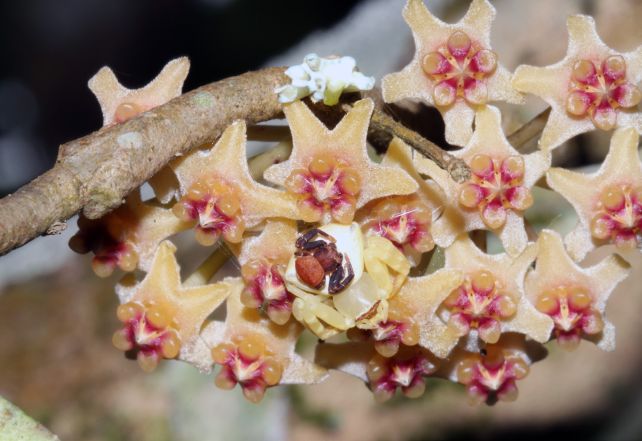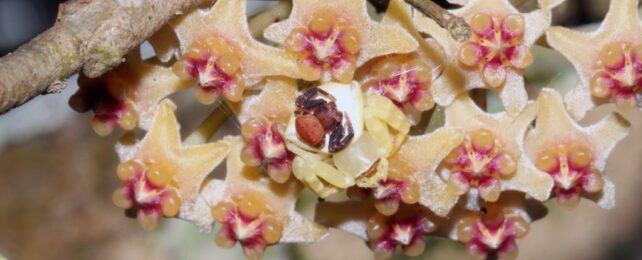When you are just a small creature in a world of things that want to eat you, one of the best strategies is to become invisible.
No, not literally. But some creatures are so adept at blending into their backgrounds that they may as well be. From birds and octopuses to frogs and caterpillars, creatures all around the world have found ingenious ways to disguise themselves from hungry eyes.
But a spider that lives in the rainforests of China has taken it up a notch. The masked crab spider (Thomisus guangxicus) appears to team up to perfect their powers of camouflage mimicry. Environmental scientists Shi-Mao Wu and Jiang-Yun Gao of Yunnan University have documented a male and a female of the species working together to disguise themselves as a flower.
It could be the first time we've ever seen cooperative camouflage in the wild.
Crab spiders are cute, colorful arachnids that pose no danger to humans. They live in environments that match their coloration, disguising themselves as features of leaves or petals. This offers protection against predators, sure, but also gives them another advantage. Crab spiders do not spin webs; rather, they are ambush predators that lie in wait to snare their own prey as it crosses their paths.
They're called crab spiders because their grabby front legs are longer than the others, giving them a similar appearance to their marine namesake. But, in comparison to crabs, crab spiders can have a much more pronounced sexual dimorphism.

In the case of the masked crab spider, the male and the female look very different indeed: the male is much smaller than the female, with different, much darker coloration. In fact, this is the case for many crab spider species, leading scientists to wonder what the male's camouflage strategy might be.
Well, Wu and Gao might have found an answer. In a tropical rainforest in Yunnan, they came across two spiders on a Hoya pandurata – a plant with pretty, waxy flowers that have a lighter corolla (the petal part) and darker pistils and stamens.
"In this image, where the male crab spider lies on the back of the conspecific female, the male appears to mimic a flower's pistils and stamens while the female appears to mimic that same flower's fused corolla," they write in their description of the encounter.
"The flower's complex color is matched as a whole only when individual spiders of both sexes are present."
The researchers told New Scientist that they believe their discovery is the first documented case of cooperative mimicry.
It's unclear, however, whether this is the case. The stacked spiders could have just been a coincidental happenstance. Or the spiders could have been engaged in mating behavior.
We could find out by continuing to observe the spiders, and other species of crab spider with similar sexual dimorphism, to see if the behavior repeats and can be linked to camouflage. Clues might also lie in the molecular clocks of both species.
If plant and spider are found to have co-evolved, Wu and Gao say, this could provide some clues about their fascinating behavior.
The researchers have published their findings in Frontiers in Ecology and the Environment: EcoPics.
